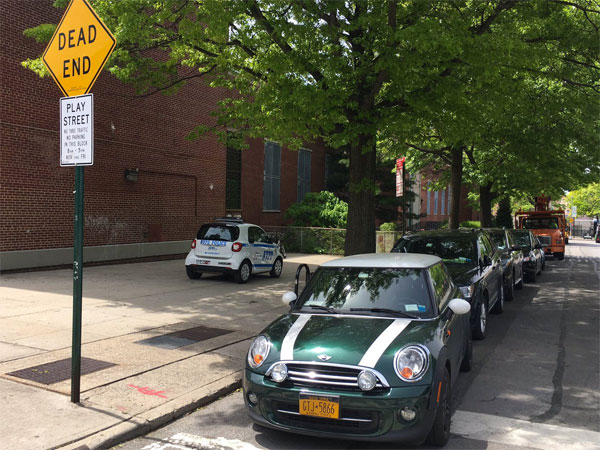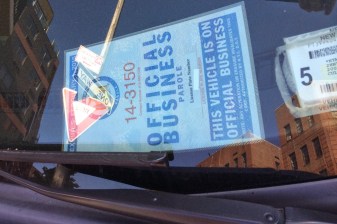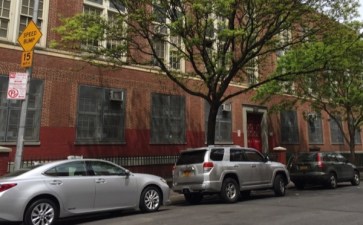The High Cost of Giving Away More Parking Placards
Mayor de Blasio's deal to hand out tens of thousands of new placards to school employees will impose about $40 million worth of congestion costs per year.

The decision last week to grant tens of thousands of new parking placards to teachers and other school personnel is classic Bill de Blasio: a freebie that’s not really free. It’s also a signifier of mayoral obtuseness about how a dense metropolis like New York City functions.
Indignation continues to mount over the parking giveaway, and not just from the usual sources. NY1 news anchor Errol Louis is challenging the mayor over placard abuse, while Marcia Kramer, CBS 2’s doyenne of driver entitlement, brought in “Gridlock” Sam Schwartz to affirm that “Handing [out] another 50,000 placards, whether to teachers or anyone else, makes no sense” in terms of managing traffic and making streets safe.
Veteran political consultant Hank Sheinkopf delivered the coup de grace, telling Kramer, “There are two cities going on here — there are de Blasio’s friends and then there’s everybody else.”
Yet to de Blasio, who is chauffeured daily from Gracie Mansion onto the FDR and over to Brooklyn to the Park Slope Y, there are no losers. “It’s still the same number of [parking] spaces,” the mayor says. “So yeah, there’ll be more people competing for those spaces. But it doesn’t change the number of spaces.”
Well, it’s also the same number of lanes into which more vehicles will be shoehorned. Apparently no one in City Hall tasked NYC DOT with quantifying the slowdowns that await other travelers when thousands of new weekday car trips begin wriggling like tadpoles to their promised free parking spots.
Or maybe the subject was raised and put aside once the true cost became apparent. I estimate that the extra traffic that the new placards will induce could impose about $40 million worth of congestion delays — a time penalty averaging $840 per placard per year. (See the notes on methodology below for an explanation of these figures.)
Like most political giveaways, then, the mayor’s bestowal of placards benefits an anointed few at the expense of the many. And these congestion costs don’t include the all-too-predictable rises in crashes and pollution from putting more vehicles in circulation.
This isn’t to single out the new placards from the tens of thousands already in use, both sanctioned and fraudulent. They clog our highways and streets just as much, per vehicle, as will the ones examined here. What’s tough to stomach is that a mayor ostensibly committed to both climate goals (an 80 percent reduction in emissions by 2050) and street-safety goals (Vision Zero) is minting a new perk that will make it harder to achieve either, while degrading, even if slightly, New York City’s efficiency as a place to live and work.
The “tragedy of the commons,” it’s called, when privileged claimants grab pieces of a finite and underpriced fishery, airshed or road network. They taught it when de Blasio was in college.
Of course, a mayor who didn’t seal himself off behind a windshield might have figured that out by himself.
Notes on methodology
I generated the figures in this post through a straightforward calculation, with these key elements:
- Based on press reports, I specified 50,000 new placards, apportioned between schools in the Manhattan Central Business District (south of 60th Street) and non-CBD schools according to student populations.
- I assumed that one new car commute would be induced for every two of the 3,000 placards issued for CBD schools and for every four of the 47,000 non-CBD placards (the difference is based on free parking’s higher monetary value in the CBD).
- The induced car trips average seven miles each way — the mean length of NYC car commutes. For CBD schools, 20 percent of the commute is assumed to be within the CBD; for non-CBD schools, that figure is 2 percent (to allow for CBD residents who teach outside the CBD).
- For baseline travel volumes, I drew on data from my BTA spreadsheet (see the “Parking Placards” tab): roughly 3.5 million weekday vehicle miles inside the CBD and 61 million outside; these are 24-hour totals, which dilutes the calculated traffic impacts.
- I applied a quadratic “speed-volume elasticity” inside the CBD and a one-for-one elasticity outside, so that a hypothetical 10 percent increase in traffic volumes induces a 21 percent worsening of speeds inside the CBD (1.10 squared equals 1.21) and a 10 percent worsening outside. These elasticities are around half of what I use in the BTA, a conservatism that lets me ignore “uninduced traffic” by which the rise in traffic might deter some current car trips.
- Baseline speeds are 10 mph inside the CBD and 21 mph outside (24-hour averages).
- Time spent in traffic is experienced as a cost of $25 per vehicle-hour within the CBD and $20 outside (the differential reflects the more affluent mix of drivers in the Manhattan core).
When the calculated slowdown in travel is averaged across all drivers and expressed in miles per hour, it hardly seems to register: traffic slows by just 0.04 mph inside the CBD and 0.06 mph outside. However, the number of vehicles being slowed down is enormous, as indicated by the VMT figures given earlier. Converted to vehicle-hours, the estimated extra time that drivers citywide sit in traffic every weekday will rise by 1,600 hours within the CBD and 8,500 hours outside the CBD, making a total of around 10,000 new lost hours a day.
Based on drivers’ value of time, the delay cost stemming from the new placards is a bit over $200,000 per day. Applied across the 200 days per year on which teachers report to schools, that amounts to $42 million a year.
An easier number to apprehend, perhaps, is the delay cost per placard, computed by dividing the $42 million annual delay cost by the assumed 50,000 new placards. The result: $840 per placard per year.



